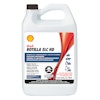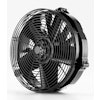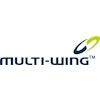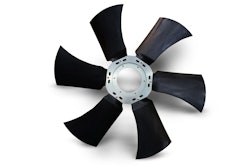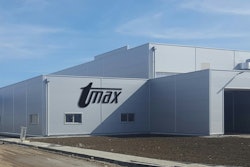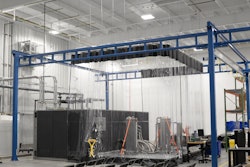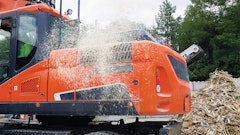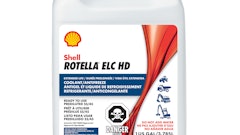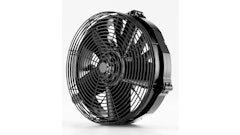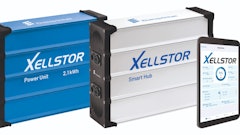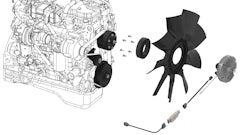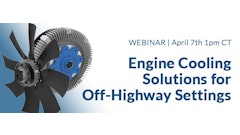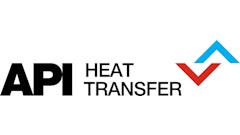
Efficient and reliable engines are crucial to keep trucks and buses economical and safe. At IAA Commercial Vehicles 2018, Thermamax presents leading-edge insulation technologies that provide improved performance and safety of electric drives and make a significant contribution to effective exhaust aftertreatment as well as to noise reduction. New at Thermamax: the Tmax-Battery Housing for maximum safety, enhanced battery range and a longer battery life cycle.
Safety and efficiency for lithium-ion systems
Renewable energies are gaining ground worldwide. In the development of alternative drives for commercial vehicles, lithium-ion batteries take center stage.
They offer impressive benefits such as emission-free drives, high efficiency and low self-discharge. But their design and technology is also susceptible to thermal risks and place new demands on fire protection in the engine compartment.
Lithium-ion batteries are chemical energy storage systems that release the stored charge through a chemical reaction. When a certain operating temperature is reached, there is a so-called thermal runaway in the battery, which means that it heats up on its own to the point of destruction. The reason is that lithium-ion batteries, unlike lead or nickel versions, must rely on flammable components.
An electronic malfunction or mechanical damage can cause the lithium ions to withdraw the oxygen stored in the cathode, which may result in oxidation of the electrolyte. This creates gases and vapors. The pressure and temperature increase. At temperatures between 120 and 300 C, the separator melts and the electrolyte starts to burn. This causes a short circuit and thermal decomposition of the cathode. The oxygen released in this process, combined with the thermal energy, ignites the other battery components and produces temperatures of over 1,000 C.
Lithium-ion batteries are classified as dangerous goods in transport or storage. They respond to their environment with great sensitivity. In any event, the energy sources should never be directly or permanently exposed to higher temperatures.
To protect lithium-ion batteries against fire, it is not enough to just develop high-temperature insulation. Instead the temperature must be monitored permanently. This is why the Tmax-Battery Housing has thermal management with high-performance cooling.
The Tmax-Battery Housing protects the environment against the effects of thermal runaway and the battery against the risks of high ambient temperatures.
More efficient Exhaust Aftertreatment
Emission guidelines are becoming stricter all the time. Since Euro VI, the permitted emission levels have been lower than ever, and the industry is implementing various solutions to comply with the standards.
Different systems for exhaust aftertreatment are used to meet the specifications. These include exhaust gas recirculation (EGR), for example, or exhaust aftertreatment with selective catalytic reduction (SCR) and the addition of AdBlue/urea, as well as oxidation catalysts (DOC) and diesel particulate filters (DPF) which reduce the particulate emissions of diesel engines.
The efficiency of the exhaust aftertreatment can be even further increased by handling high temperatures correctly. With Tmax-Integral Insulation, Thermamax cooperates closely with leading vehicle and component manufacturers to ensure that the temperatures are optimal at all points of the exhaust system – for the most efficient exhaust aftertreatment possible.
More effective Noise Reduction
The EU regulation 540/2014 regarding the “noise level of motor vehicles” also puts manufacturers of commercial vehicles under pressure to develop and implement new solutions for noise reduction. Between 2016 and 2026, the permitted limit values are expected to be reduced by 3-4 decibels (dB) in total. Three decibels correspond to a reduction in the sound pressure by half. For vehicle manufacturers, reaching these values with a reasonable effort is a great challenge.
Several components contribute to the generation of vehicle noise, such as engine and transmission elements and tires – with various intensities, depending on the speed. In a dense urban area, engine noises at 50 km/h are the main source. For that reason, many manufacturers of commercial vehicles must start directly at the engine. Some of the measures include the optimization of the engine structure, auxiliary power units or injection. At higher speeds, the rolling sounds of the tires play the largest role. In road construction, this has therefore led to great efforts and expertise to reduce noise. However, together these measures are not enough to reach the required limit values. This is why active sound insulation is becoming increasingly important.
Noise absorbing measures in the engine compartment are nevertheless not straightforward as they need space. Using Tmax-SONETHERM means that the hot surfaces of the exhaust line components are also available as the system combines the thermal insulation with the principle of noise absorption.
Tmax-SONETHERM, the acoustically-optimized Tmax-Integral Insulation, comprises a high-temperature resistant shaped fiber element with excellent sound-absorbing characteristics and a perforated metallic outer shell. The small holes in the surface of the outer shell "suck" the noise out of the engine compartment thereby reducing the sound level.

